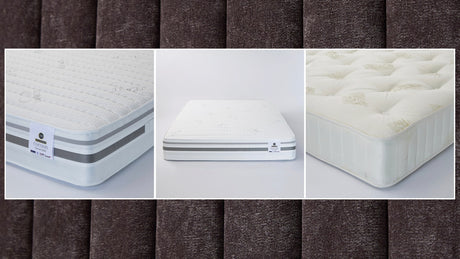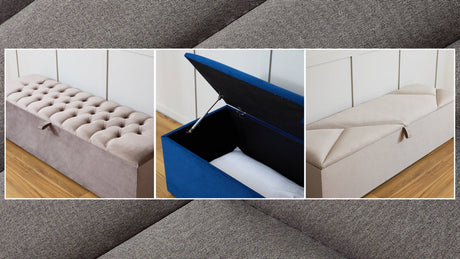Find the Right Mattress Firmness for Your Best Night’s Sleep
Choosing the right mattress tension—also called firmness level—is crucial for sleep quality, spinal alignment, and overall comfort. Whether you’re a side sleeper looking for a soft feel, a back sleeper needing firmer support, or somewhere in between, this guide will help you confidently pick the perfect mattress for your sleep style.
Table of Contents:
- 1. What Is Mattress Tension?
- 2. Why Mattress Tension Matters
- 3. Which Firmness Is Right for Your Sleep Position?
- 4. Firmness Guide by Body Weight
- 5. Mattress Types & Their Tension Levels
- 6. What Else Affects Mattress Firmness?
- 7. Which Firmness Is Best for You?
- 8. Important Considerations
- 9. Key Takeaways
- 10. Ready to Find Your Perfect Mattress?
- 11. FAQs
1. What Is Mattress Tension?
Mattress tension refers to how soft or firm a mattress feels when you lie down. The three main types are:
- Soft Mattresses – Ideal for side sleepers and lighter individuals who need pressure relief on hips and shoulders.
- Medium Mattresses – A versatile choice for combination sleepers or couples with different sleep styles.
- Firm Mattresses – Best for back and stomach sleepers or those who need extra spinal support.
Tip: Firmness is not the same as support. Even a soft mattress can be supportive with the right construction.
2. Why Mattress Tension Matters
The wrong mattress firmness can lead to poor sleep, back pain, or joint discomfort. Two key factors affect the ideal firmness level for each person:
-
Your Sleeping Position:
- Side sleepers – Soft to Medium mattresses help cushion pressure points like hips and shoulders.
- Back sleepers – Medium to Firm mattresses promote better spinal alignment.
- Stomach sleepers – Firm mattresses prevent the lower back from arching too much.
- Your Body Weight: Heavier sleepers may need a firmer mattress to avoid sinking too deeply.
- Back Pain or Joint Issues: Orthopaedic or extra firm mattresses may help relieve pressure and maintain alignment.
Tip: Side-lift ottoman beds are ideal for narrow rooms with limited space at the foot of the bed.
3. Which Firmness Is Right for Your Sleep Position?
Different sleep positions put pressure on different parts of the body, so the right mattress firmness helps keep your spine aligned and muscles relaxed while you sleep.
4. Firmness Guide by Body Weight
| Weight Range | Ideal Firmness Level |
|---|---|
| Under 10 Stone | Soft to Medium |
| 10 to 16 Stone | Medium to Firm |
| Over 16 Stone | Firm to Extra Firm |
Choosing based on your body weight helps maintain spinal alignment and prevent pressure buildup.
5. Mattress Types & Their Tension Levels
Different mattress materials influence how firm or soft they feel:
- Memory Foam: Contours to the body, great for pressure relief. Available in various firmness levels.
- Pocket Sprung: Offers targeted support and a more traditional bounce.
- Hybrid Mattresses: Combine foam and springs for balanced comfort and support.
- Latex Mattresses: Naturally firm and durable, ideal for those wanting eco-friendly support.
6. What Else Affects Mattress Firmness?
Factors like age, medical conditions, and whether you sleep with a partner can influence the firmness that works best for you. Motion isolation, temperature regulation, and edge support also come into play.
7. Which Firmness Is Best for You?
Here’s a quick guide based on common needs:
| Sleep Style | Recommended Tension | Best Mattress Type |
|---|---|---|
| Side Sleeper | Soft to Medium | Memory Foam, Hybrid |
| Back Sleeper | Medium to Firm | Hybrid, Pocket Sprung |
| Stomach Sleeper | Firm | Latex, Firm Hybrid |
| Heavyweight Sleeper | Medium-Firm to Firm | Hybrid, Latex |
| Back Pain Sufferer | Firm or Orthopaedic | Orthopaedic, Latex |
| Hot Sleeper | Medium (Cooling) | Hybrid with Cooling Tech |
8. Important Considerations
Couples with Different Sleep Preferences:
A dual tension mattress or one with zoned support can be the perfect compromise when partners have different comfort needs.
Best Mattress for Heavier People:
If you weigh more than 16 stone (100kg), look for an extra firm mattress designed to offer more durability and support without sagging.
Hot Sleeper?
A hybrid mattress with cooling technology helps regulate body temperature and promotes airflow—perfect if you tend to sleep hot.
9. Key Takeaways
- Mattress tension impacts your spinal health, comfort, and sleep quality.
- Your ideal firmness depends on sleep position, body weight, and personal preferences.
- Matching the right tension to your needs helps prevent discomfort and promotes restorative sleep.
10. Ready to Find Your Perfect Mattress?
Explore our full collection of mattresses by firmness to match your sleep style and support needs. Or speak to our experts for personalised recommendations.
11. Frequently Asked Questions
Mattress tension, also known as firmness, describes how soft or firm a mattress feels when you lie on it. It affects your comfort and spinal support during sleep.
Consider your sleeping position, body weight, and any specific health issues like back pain. Side sleepers usually prefer softer mattresses, while back and stomach sleepers often need firmer support.
Yes, choosing the right firmness helps maintain proper spinal alignment, which can reduce or prevent back pain. Medium to firm mattresses are often recommended for people with back issues.
Memory foam and hybrid mattresses offer a range of firmness options. Latex mattresses tend to be naturally firmer and more durable. Choose based on your comfort preference and support needs.
Not necessarily. Firmness should match your body type and sleep position. Too firm can cause pressure points, while too soft may not provide enough support.
If you sink too much into the mattress or feel discomfort on pressure points, it may be too soft. If you feel like you’re sleeping on a hard surface without contouring, it might be too firm.
Yes, factors like weight changes, aging, or health conditions can affect your mattress needs. It’s a good idea to reassess your mattress firmness every few years.
Absolutely! Look for mattresses with zoned support, adjustable firmness, or consider split mattresses that allow each side to have different tension levels.












